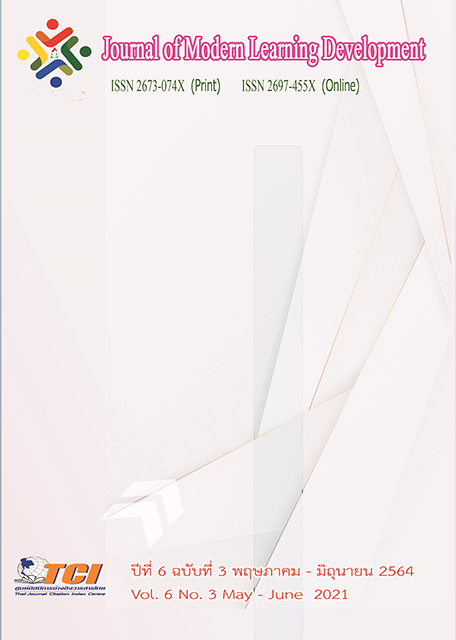Innovation and Technology for Increase the Competitiveness in the Markets of Jasmine Rice Ban Khok Phon Community Enterprise’s, Kanthararom Subdistrict, Khukhan District, Sisaket Province
Main Article Content
Abstract
This research aimed to 1) Study the current conditions of marketing and distribution the channels of jasmine rice Ban Khok Phon Community Enterprise’s 2) Study to the model of Application to innovation and technology into Increase the competitiveness in the markets of jasmine rice Ban Khok Phon Community Enterprise’s 3) to develop monitoring system of jasmine rice production processes via QR Code of Jasmine rice enterprise group at Ban KhokPhon Community. This mixed method research was divided into qualitative research method with in-depth interview and collecting data from 47 key informants and conducted by collecting data from 10 people of focus group discussion and questionnaire regarding the condition of digital information technology of the community enterprise group and the explicit knowledge in applying information technology. The last method was conducted by using the workshop and quantitative research method with the satisfaction survey and collecting data from 30 members of Jasmine rice enterprise group using monitoring system development of jasmine rice production processes via QR Code of Jasmine rice enterprise group. These data were summarized, analyzed and presented in descriptive pattern.
The findings were: 1. Regarding the current condition in marketing and distribution channels of Jasmine rice enterprise group, it originated from farmers gathering in the community to have bargaining power of the rice price selling to the rice mills at a fair price for both parties. At present, the current marketing condition and distribution channels of the enterprise group are at the household production level. Also, the product distribution is at the level of community, rice mills and shops in the neighborhood due to the limitation of distribution channels that causes distribution problem leading to income shortage. In order to increase the value of organic jasmine rice production, the group has joined PGS system "Community Certified" which is a form of organic agriculture certification, 2. The group uses technology in the system management using the line application to exchange information of the group. The group members have explicit knowledge in applying marketing technology at a low level. When considering each item, it was found that the group members have knowledge in using the internet at the highest level and are able to applying technology and innovation of information system in business of the group at the least level, respectively and 3. The marketing channels were developed by information system via Facebook and QR code using the Facebook page. The result of satisfaction survey on development of monitoring system and tracking production processes of Jasmine Rice via QR Code of Jasmine rice enterprise group was found that farmers satisfied to participate in training on the development of monitoring system of jasmine rice production processes via QR Code at high level. When considering each item, it was found that giving an opportunity to ask and comment was at the highest level.
Article Details
References
กรมส่งเสริมการเกษตร. (2557). วิสาหกิจชุมชน. กรุงเทพมหานคร: กรมส่งเสริมการเกษตร กระทรวงเกษตร และสหกรณ์.
โกสินทร์ ชำนาญพล และ สุดาใจ โล่ห์วนิชชัย. (2562). การพัฒนารูปแบบเทคโนโลยีดิจิทัลเพื่อส่งเสริมศักยภาพผู้ประกอบการ. วารสารราชพฤกษ์. 17 (2), 130-138.
ขวัญจุฑา คำบันลือ และคณะ. (2560). การประยุกต์ใช้เทคโนโลยีคิวอาร์โค้ดเพื่อส่งเสริมกิจกรรมการเรียนรู้สำหรับศูนย์รวบรวมสายพันธุ์กล้วยเฉลิมพระเกียรติ จังหวัดกำแพงเพชร. วารสารศึกษาศาสตร์มหาวิทยาลัยนเรศวร. 19 (1), 184-193.
จิตติพัฒน์ จำเริญเจือ และวิภาวี กฤษณะภูติ. (2557). แนวทางการพัฒนาการจัดการศูนย์ส่งเสริมและผลิตเมล็ดพันธุ์ข้าวชุมชนในจังหวัดกาฬสินธุ์สู่ความยั่งยืน. หลักสูตรศิลปศาสตรมหาบัณฑิต สาขาวิชาพัฒนาสังคมคณะมนุษยศาสตร์และสังคมศาสตร์. บัณฑิตวิทยาลัย: มหาวิทยาลัยขอนแก่น.
ฉัตยาพร เสมอใจ. (2558). กลยุทธ์ตลาดสาหรับวิสาหกิจชุมชน: กรณีศึกษากระเทียมโทนดองอบต.บางกร่างจังหวัดนนทบุรี. วารสารวิชาการราชภัฏพระนคร. 6 (2), 104-115.
วิรัลพัชร บางปลากด. (2562). ศึกษาวิเคราะห์หลักพุทธธรรมในการพึ่งตนเองของกลุ่มเกษตรอินทรีย์บ้านพันเสา อำเภอบางระกา จังหวัดพิษณุโลก. Journal of MCU Peace Studies. 7 (3), 838-853.
ศิริวรรณ เสรีรัตน์ และคณะ. (2552). การบริหารการตลาดยุคใหม่. กรุงเทพมหานคร: ธรรมสาร.
สรธรรม เกตตะพันธุ์ และคณะ. (2561). ผลของการใช้ระบบการรับรองแบบมีส่วนร่วม (พีจีเอส) ในชุมชนเกษตรอินทรีย์. Thai Journal of Science and Technology. 7 (4), 333–354.
สัจจา ไกรศรรัตน์ และเจนคณิต สุขสัมฤทธิ์. (2561). การสร้างอัตลักษณ์ตราสินค้าสับปะรดจังหวัดราชบุรีโดยใช้สิ่งบ่งชี้ทางภูมิศาสตร์และเทคโนโลยีสื่อสารดิจิทัลระบบคิวอาร์โค้ด. กรุงเทพมหานคร: สำนักงานกองทุนสนับสนุนการวิจัย.
เสรี พงศ์พิศ. (2546). ฐานคิดจากแผนแม่บทสู่วิสาหกิจชุมชน. กรุงเทพมหานคร: สำนักพิมพ์ภูมิปัญญาไท.
อภิชาต ใจอารีย์. (2561). แนวทางการขับเคลื่อนเกษตรอินทรีย์เพื่อสร้างความมั่นคงด้านอาหารปลอดภัยสำหรับชุมชน : บทสะท้อนจากภาคปฏิบัติการ. วารสารมหาวิทยาลัยศิลปากร. 38, (5), 1–17.
อาภา หวังเกียรติ และสมภพ ดอนดี. (2562). ตลาดอินทรีย์ของชาวนาภาคกลาง. กรุงเทพมหานคร: สำนักงานกองทุนสนับสนุนการสร้างเสริมสุขภาพ (สสส.) และมูลนิธิชีวิตไท (Local Act).


